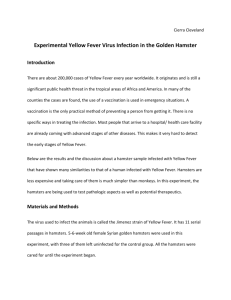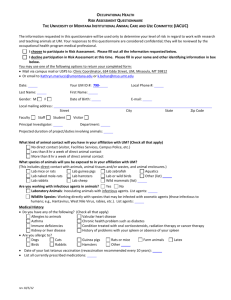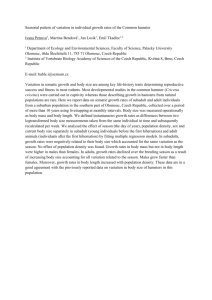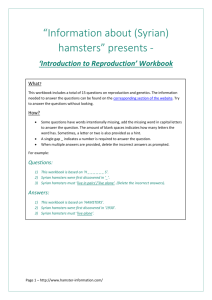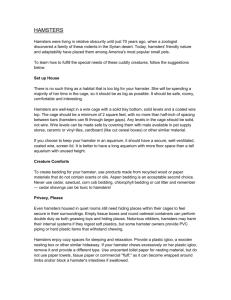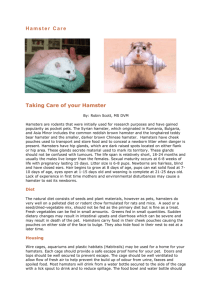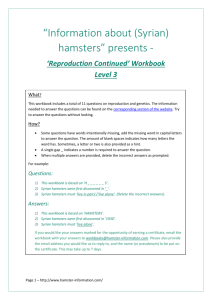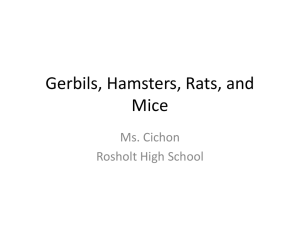Chapter 28 Management Husbandry and Colony Health
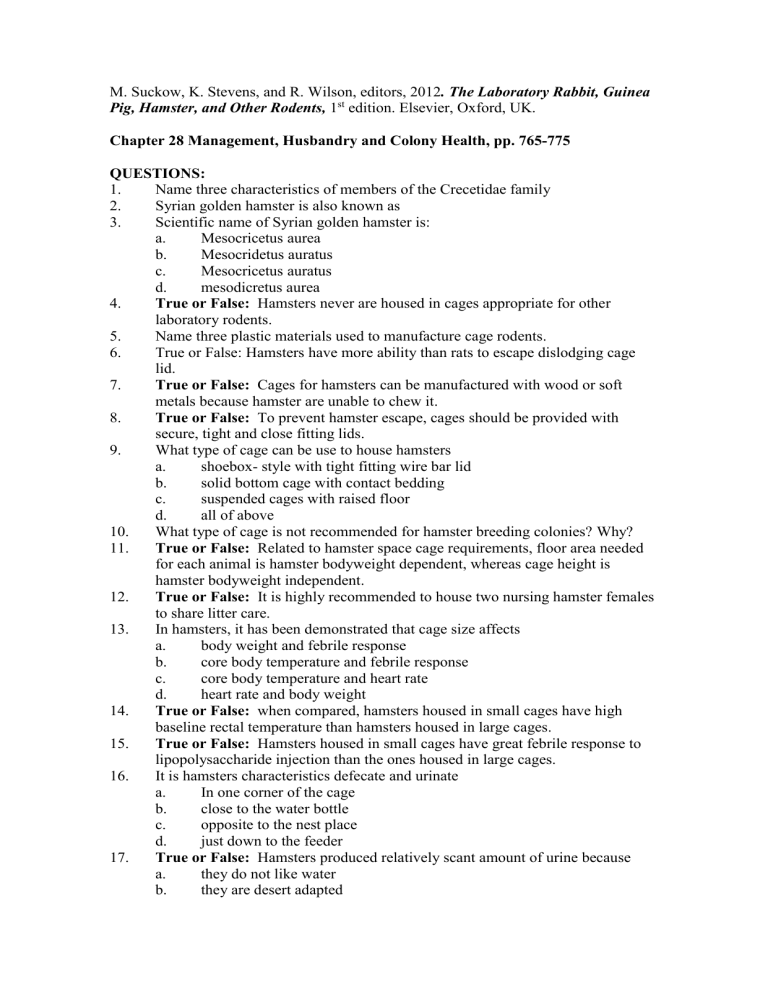
M. Suckow, K. Stevens, and R. Wilson, editors, 2012 . The Laboratory Rabbit, Guinea
Pig, Hamster, and Other Rodents, 1 st
edition. Elsevier, Oxford, UK.
Chapter 28 Management, Husbandry and Colony Health, pp. 765-775
QUESTIONS:
1. Name three characteristics of members of the Crecetidae family
2. Syrian golden hamster is also known as
3. Scientific name of Syrian golden hamster is: a. Mesocricetus aurea b. Mesocridetus auratus c. Mesocricetus auratus d. mesodicretus aurea
4. True or False: Hamsters never are housed in cages appropriate for other laboratory rodents.
5. Name three plastic materials used to manufacture cage rodents.
6. True or False: Hamsters have more ability than rats to escape dislodging cage lid.
7. True or False: Cages for hamsters can be manufactured with wood or soft metals because hamster are unable to chew it.
8. True or False: To prevent hamster escape, cages should be provided with secure, tight and close fitting lids.
9. What type of cage can be use to house hamsters a. shoebox- style with tight fitting wire bar lid b. solid bottom cage with contact bedding c. suspended cages with raised floor d. all of above
10. What type of cage is not recommended for hamster breeding colonies? Why?
11. True or False: Related to hamster space cage requirements, floor area needed for each animal is hamster bodyweight dependent, whereas cage height is hamster bodyweight independent.
12. True or False: It is highly recommended to house two nursing hamster females to share litter care.
13. In hamsters, it has been demonstrated that cage size affects a. body weight and febrile response b. core body temperature and febrile response c. core body temperature and heart rate d. heart rate and body weight
14. True or False: when compared, hamsters housed in small cages have high baseline rectal temperature than hamsters housed in large cages.
15. True or False: Hamsters housed in small cages have great febrile response to lipopolysaccharide injection than the ones housed in large cages.
16. It is hamsters characteristics defecate and urinate a. In one corner of the cage b. close to the water bottle c. opposite to the nest place d. just down to the feeder
17. True or False: Hamsters produced relatively scant amount of urine because a. they do not like water b. they are desert adapted
c. they have small kidneys d. they have high levels of ADH hormone
18. True or False: Hamsters have no preference for contact bedding material in cages if they are provided with nesting material.
19. True or False: Hamsters that have long term access to running wheel can develop foot lesions.
20. Why it is not recommended the use of untreated soft wood, i.e. pine, as bedding material for rodent species?
21. True or False: Recommended ventilator rates when housing hamsters are 20-
25 changes per hour.
22. True or False: Animal facilities that house hamsters have to be adequately ventilated to minimize the development of odors and moisture condensations.
23. True or False: There are no acceptable for hamsters ventilation rate recommendations when or housing other rodent species.
24. Name four characteristics that can define the adequate illumination in an animal facility.
25. How long from floor light intensity levels are measured in an animal facility? a. 0,5 m b. 0,75 m c. 1 m d. 1, 25 m
26. True or False: Hamsters are strictly nocturnal both in captivity and in wild.
27. True or False: Hamsters are seasonal breeders that modulate reproduction with photoperiod.
28. True or False: Female hamsters in the wild are primarily diurnal
29. Hamsters breeding colonies are better maintained under a. 12:12 light – dark cycle b. 14:10 light – dark cycle c. 10:14 light – dark cycle d. 16:8 light – dark cycle
30. Name four changes that can be induced in hamsters when photoperiod is altered
31. The thermo neutral zone for hamsters is approximately a. 22-24ºC b. 24-26ºC c. 26-28ºC d. 28-30ºC
32. Define thermo neutral zone for an animal.
33. True or False: Syrian golden hamster originates from desert environment and they are unable to adapt to cooler temperatures below 15ºC.
34. Short term hibernation can be induced in hamsters if they are exposed to a. 10-12ºC and shortened light cycle b. 3-5ºC and shortened light cycle c. 0-2ºC and shortened light cycle d. 6-8ºC and shortened light cycle
35. True or False: as other laboratory rodent species, for hamsters environmental relative humidity recommendations are 30-70%.
36. The three parts of female hamsters burrow system in the wild are:
37. In the wild, hamsters live a. in pairs b. solitary
c. in harem d. one sex groups
38. Because hamster in the wild spend time underground, enrichment devices more recommended are a. pipe or tube b. shelters c. nest material d. all of above
39. True or False: only captive bred hamsters are able to create nests.
40. True or False: Nest building behavior is the same in pregnant and nonpregnant female hamsters.
41. True or False: As enrichment method, hamsters can be provided with food pellets on the cage floor because they forage food on the wild.
42. True or False: Hamsters need to be supplemented with grains, fruits and vegetables if they are fed with mice.
43. What of the next affirmations is true related to hamster nutrition a. feed consumption is different in males and females b. they have a forestomach that acts like a rumen c. they need 45-60% protein level in the diet d. it is mandatory to supply diet with K vitamin
44. Name three reasons to provide food in hamster cage floor.
45. True or False: If feed hopper has narrow slots hamsters can be unable or have high difficulty to obtain food and their mortality and morbidity will increase.
46. Name four characteristics of hamster stomach.
47. What is the protein source that promotes increased weight gain in hamsters? a. casein b. soybean c. oat d. fish
48. Which is a good carbohydrate source for hamsters? a. fructose b. lactose c. wheat gluten d. cornstarch
49. Name four consequences to increase up to 60% the presence of carbohydrates in hamster diet.
50. True or False: Hamsters fed with diet with high levels of refined sugars and no fiber have shown high mortality
51. True or False: Main source of vitamin K for hamsters is their feces, because they are coprophagic.
52. True or False: Male and female hamsters have same level of water consumption.
53. Name three consequences to fed hamsters with vitamin E deficient diet.
54. Vitamin A deficiency in hamsters can lead to a. abnormal development b. alopecia and a course hair coat c. xeroftalmia d. all of above
55. Hamster sexual maturity occurs at a. 6 weeks
b. 4 weeks c. 5 weeks d. 7 weeks
56. Hamster copulatory activity can began at a. 6 weeks b. 4 weeks c. 5 weeks d. 7 weeks
57. True or False: To verify sexual maturity in male hamsters, a penile smear technique can be performed to identify spermatozoa presence.
58. Estrus in female hamsters begins at a. 6-8 weeks b. 4-5 weeks c. 7-9 weeks d. 10-12 weeks
59. Reproductive senescence in both male and female hamster occur at a. 12 months b. 13 months c. 14 months d. 15 months
60. How long is estrus cycle in female hamsters? a. 4 days b. 5 days c. 6 days d. 7 days
61. The end of ovulation in female hamster can be identified by a. female adopted lordosis posture b. vaginal discharge is observed c. stop feed 24 hours d. aggressive behavior
62. True or False: Postovulatory vaginal discharge in female hamsters is an opaque, red and fluid liquid that indicated the animal have reached estrus the day before.
63. Female hamsters can be successfully mated a. morning of the third day following postovulatory discharge b. evening of the third day following postovulatory discharge c. morning of the fourth day following postovulatory discharge d. morning of the fourth day following postovulatory discharge
64. True or False: As mice, postpartum estrus in female hamsters is ovulatory.
65. What of the next is true related with hamster mating? a. female tolerate male only during estrus b. males mount females only one time c. female in estrus exhibit kyphosis when male approaches d. all of above
66. Gestational period of hamsters is approximately a. 17 days b. 20,5 days c. 19 days d. 15,5 days
67. Common method for breeding hamsters is
a. pair mating b. hand- mating c. polygamous mating d. all of above
68. True or False: When hamsters are mated in a trio, animals have to be separated after 14 days and female housed individually for parturition.
69. True or False: Female hamster is receptive to the male when shows a posture of lordosis with tail erect and hind limbs spread apart.
70. Hamsters are born______________, with __________ and _________ closed
71. True or False: In newborn hamsters, eyes open before the ears
72. Hamster litter can be weaned at a. 21 days b. 12 days c. 15 days d. 18 days but it is common to wean them at a. 21-28 days b. 17-24 days c. 24- 32 days d. 19-25 days
73. Name four consequences if hamsters are infected by microbiological agents.
74. Briefly define biosecurity program in animal facility.
75. Four important parameters in a microbiological monitoring program are:
76. Four variables that influence the frequency of testing in a microbiological monitoring program are:
77. Selection of agents included in a microbiological monitoring program is based on a. risk to human health b. cause disease in hamsters c. interfere with research outcome d. all of above
78. Name three agents commonly included in hamster microbiologic monitoring program.
79. True or False: Hamster infection with pneumonia virus of mice is clinical silent but experimental infection produce interstitital pneumonia
80. True or False: Sendai virus infection in hamsters produce gastrointestinal disease with weakness.
81. Name five bacterial agents included routinely in hamster microbiologic monitoring.
82. True or False: Hamsters have been proposed as a reservoir species for zoonotic helicobacteriosis.
83. Hamsters are an established host for a. Helicobacter bilis b. Helicobacter cinaedi c. Helicobacter genius d. Helicobacter typhlonicus
84. The two more common agents identified in hamster acariasis are
_______________ and ______________ .
85. The primary nematodes found in the intestinal tract of hamsters are pinworms of the genus:
86. Name four pinworms that can infect hamsters.
87. True or False: Records have to show what data have been collected but not under what conditions they were collected.
88. True or False: A criteria to retired breeders can be the progressive decrease of size litter obtained.
89. Parameters for proper management of breeding colonies are: a. parenterage of animals, size litter, age of animals b. age of animals, sex, animal identification c. size litter, source of animals, strain d. parenterage of animals, purchase data, IACUC protocol number
90. True or False: In husbandry record it is recommended to register both high and low room temperature daily.
ANSWERS:
1. have large check pouches, short tail and relatively thick body
2. Mesocricetus auratus
3. c
4. F
5. polycarbonate, polusulfone, polypropylene
6. T
7. F
8. T
9. d
10. suspended wire floor caging, because small animals may become entrapped or fall through the wire mesh flooring
11. T
12. F
13. b
14. T
15. F
16. a
17. T
18. T
19. T
20. Because it contains aromatic hydrocarbons capable of inducing hepatic microsomal and cytotoxicity in rodents
21. F
22. T
23. F
24. allow safe working conditions for personnel, housekeeping, adequate animal observation and preserve circadian cycles.
25. c
26. F
27. T
28. T
29. b
30. alteration on: circulating levels of luteinizing hormone, circulating levels of follicle stimulating hormone, testicular development and spermatogenesis and time of parturition
31. d
32. The temperature range asscociated with minimal metabolic expenditure
33. F
34. b
35. T
36. nest chamber, urination chamber, food storage chamber
37. b
38. d
39. F
40. F
41. T
42. T
43. b
44. as enrichment because hamsters forage food, to avoid difficulty tom get food from feeder, because hamsters have broad muzzle compared with similar size rodents, easy food access for young hamsters which begin to eat solid al 7- 10 days old
45. T
46. hamster stomach consist in a forestomach and glandular stomach, forestomach contains microorganisms similar to those of the rumen, that allow ingesta fermentation and is a source of volatile fatty acid forestomach allows to digest and utilize lower- quality protein forestomach is not required for animal maintenance if adequate diet is provided
47. b
48. d
49. increased food consumption, development of obesity, hiperinsulinemia, hypertriglyceridemia
50. T
51. T
52. F
53. testicular degeneration,, muscular dystrophy, decreased growth
54. d
55. a
56. b
57. T
58. a
59. c
60. a
61. b
62. F
63. b
64. F
65. a
66. d
67. b
68. T
69. T
70. hairless, ears, eyes
71. F
72. c, a
73. affect animal health, alter animal physiology, introduce experimental variables that can alter experimental results, can be a zoonotic risk for people working with these animals
74. all measures taken to prevent the introduction, contain and when necessary, eradicate adventitious infections and protect the microbiologic integrity of animals maintained and used in research and breeding for scientific purposes
75. number of animals to test, frequency of testing, agents to screen, appropriate testing methodology for each agent
76. historical contamination rates, health quality of the colony, financial resources, sensitivity of research to contamination
77. d
78. lymphocytic choriomeningitis virus, pneumonia virus of mice, sendai virus
79. T
80. F
81. Clostridium piliforme, salmonella, pasteurella, streptococcus pneumoniae, corynebacterium kutscheri
82. T
83. b
84. Demodex criceti, Demodex aurati
85. Syphacia
86. Syphacia mecoriceti, Shyphacia criceti, Syphacia obvelata, Syphacia muris
87. F
88. T
89. a
90. T

